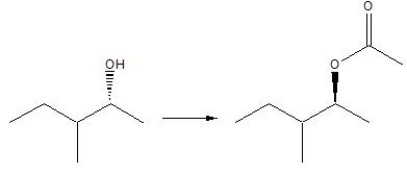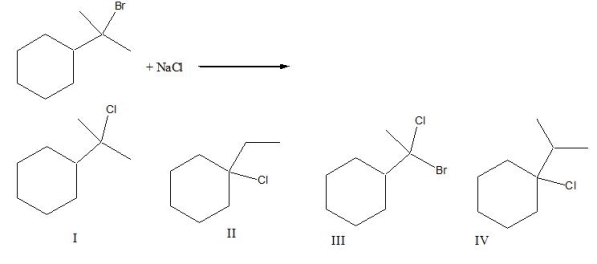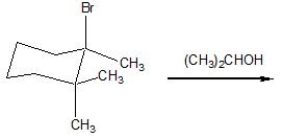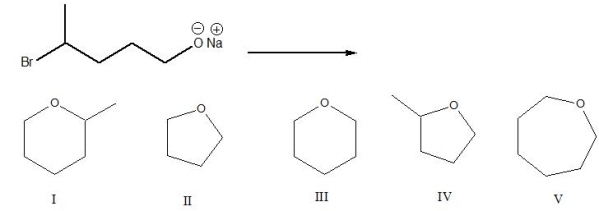A) I
B) II
C) III
D) IV
E) V
G) A) and C)
Correct Answer

verified
Correct Answer
verified
Multiple Choice
Which of the following is NOT a nucleophile?
A) OH-
B) NH3
C) CH3OH
D) NH4+
E) All of these
G) A) and D)
Correct Answer

verified
Correct Answer
verified
Multiple Choice
Which of the following is a substitution reaction? 
A) I
B) II
C) III
D) IV
F) B) and D)
Correct Answer

verified
Correct Answer
verified
Essay
Provide the reagents necessary to carry out the following conversion. 
Correct Answer

verified
Correct Answer
verified
Multiple Choice
Which of the following alkyl halides will undergo the fastest SN1 reaction? 
A) I
B) II
C) III
D) IV
E) V
G) B) and E)
Correct Answer

verified
Correct Answer
verified
Multiple Choice
Predict the product for the following SN1 reaction. 
A) I
B) II
C) III
D) IV
F) None of the above
Correct Answer

verified
Correct Answer
verified
Multiple Choice
Predict the product for the following reaction. 
A) I
B) II
C) III
D) IV
E) None of these
G) B) and E)
Correct Answer

verified
Correct Answer
verified
Short Answer
What is the IUPAC name for the following compound? 
Correct Answer

verified
1,1-dibrom...View Answer
Show Answer
Correct Answer
verified
View Answer
Multiple Choice
Which of the following is true about the stereochemistry of SN1 reaction?
A) retention of configuration at the electrophilic center
B) inversion of configuration at the electrophilic center
C) 50:50 mixture of retention and inversion of configuration at the electrophilic center
D) slightly more inversion than retention at the electrophilic center
E) slightly more retention than inversion at the electrophilic center
G) A) and D)
Correct Answer

verified
Correct Answer
verified
Multiple Choice
Which of the following compounds will undergo rearrangement in an SN1 reaction? 
A) I
B) II
C) III
D) IV
E) V
G) A) and E)
Correct Answer

verified
Correct Answer
verified
Multiple Choice
Which of the following is the rate equation for the following SN1 reaction? ![Which of the following is the rate equation for the following S<sub>N</sub>1 reaction? A) Rate = k[H<sub>2</sub>O] B) Rate = k[1-chloro-1-methylcyclohexane] [H<sub>2</sub>O] C) Rate = k[chloride ion] D) Rate = k[1-chloro-1-methylcyclohexane]](https://d2lvgg3v3hfg70.cloudfront.net/TB3185/11eab459_a6c2_1e47_acdb_c56716ea190e_TB3185_00.jpg)
A) Rate = k[H2O]
B) Rate = k[1-chloro-1-methylcyclohexane] [H2O]
C) Rate = k[chloride ion]
D) Rate = k[1-chloro-1-methylcyclohexane]
F) A) and B)
Correct Answer

verified
Correct Answer
verified
Multiple Choice
What set of reaction conditions would favor an SN1 reaction on 2-bromo-3-methylbutane?
A) weak nucleophile in a protic solvent
B) weak nucleophile in an aprotic solvent
C) strong nucleophile in a protic solvent
D) strong nucleophile in an aprotic solvent
F) B) and D)
Correct Answer

verified
Correct Answer
verified
Multiple Choice
Rank the following compounds from most to least reactive in an SN1 reaction. 
A) I>IV>II>III
B) II>III>I>IV
C) III>II>I>IV
D) I>III>II>IV
E) IV>III>I>II
G) A) and E)
Correct Answer

verified
Correct Answer
verified
Essay
Predict the product for the following reaction. 
Correct Answer

verified
Correct Answer
verified
Multiple Choice
Predict the major product for the following reaction. 
A) I
B) II
C) Both II & III
D) Both I & IV
E) V
G) A) and B)
Correct Answer

verified
Correct Answer
verified
Multiple Choice
Predict the product for the following reaction. 
A) I
B) II
C) III
D) IV
E) None of these
G) B) and D)
Correct Answer

verified
Correct Answer
verified
Multiple Choice
Which of the following is a primary alkyl halide?
A) (CH3) 2CHCH2Cl
B) (CH3) 2CClCH2CH3
C) (CH3) 2CHCHClCH3
D) (CH3) 2CHCH2CCl(CH3) 2
F) A) and C)
Correct Answer

verified
Correct Answer
verified
Multiple Choice
Which of the following alkyl halides is essentially unreactive in an SN2 reaction? 
A) I
B) II
C) III
D) IV
E) V
G) B) and E)
Correct Answer

verified
Correct Answer
verified
Multiple Choice
Predict the product for the following SN2 reaction. 
A) I
B) II
C) III
D) IV
E) V
G) A) and C)
Correct Answer

verified
Correct Answer
verified
Multiple Choice
What set of reaction conditions would favor an SN2 reaction on 2-bromo-3-methylbutane?
A) weak nucleophile in a protic solvent
B) weak nucleophile in an aprotic solvent
C) strong nucleophile in a protic solvent
D) strong nucleophile in an aprotic solvent
F) C) and D)
Correct Answer

verified
Correct Answer
verified
Showing 61 - 80 of 123
Related Exams